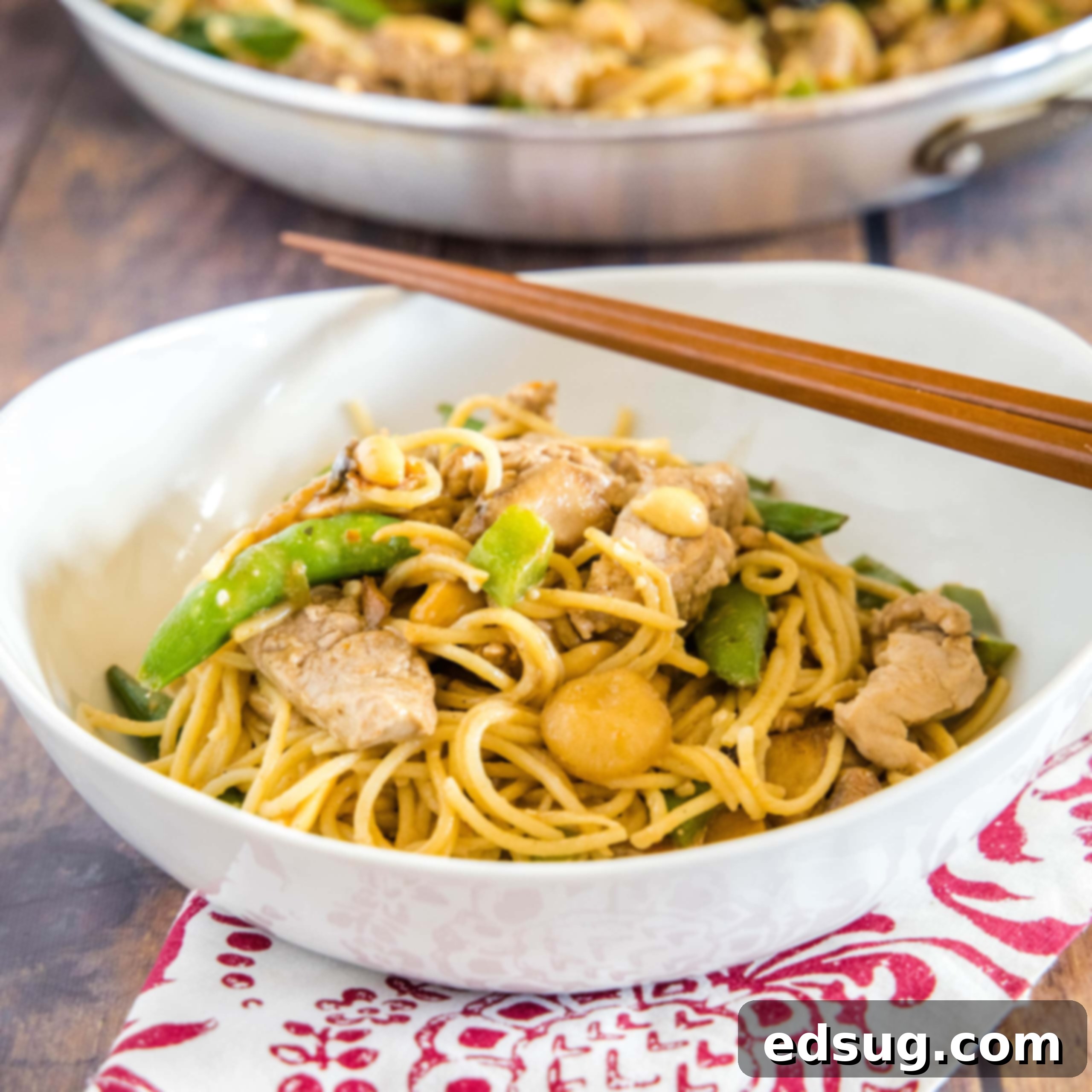Quick & Easy Homemade Stir Fry Noodles with Spicy Peanut Sauce
In today’s fast-paced world, finding a delicious yet quick dinner solution is a constant quest. If you’re like me, you appreciate a meal that doesn’t demand hours in the kitchen but still delivers incredible flavor. That’s precisely what you’ll find with these amazing Asian Stir Fry Noodles. Imagine enjoying a restaurant-quality meal, customized to your exact preferences, all prepared and ready to serve in under 30 minutes! Forget soggy takeout or expensive delivery fees; this homemade version is not only faster and more economical, but it also allows you complete control over the freshness and quality of your ingredients.
These Stir Fry Noodles are designed for busy weeknights, offering a perfect blend of convenience and gourmet taste. They feature tender noodles, an assortment of crisp-tender vegetables, your choice of protein (I used succulent pork tenderloin in this example), and a truly irresistible peanut sauce that delivers a delightful kick. This recipe transforms ordinary pantry staples into an extraordinary meal, proving that healthy, flavorful, and quick dinners are absolutely achievable.
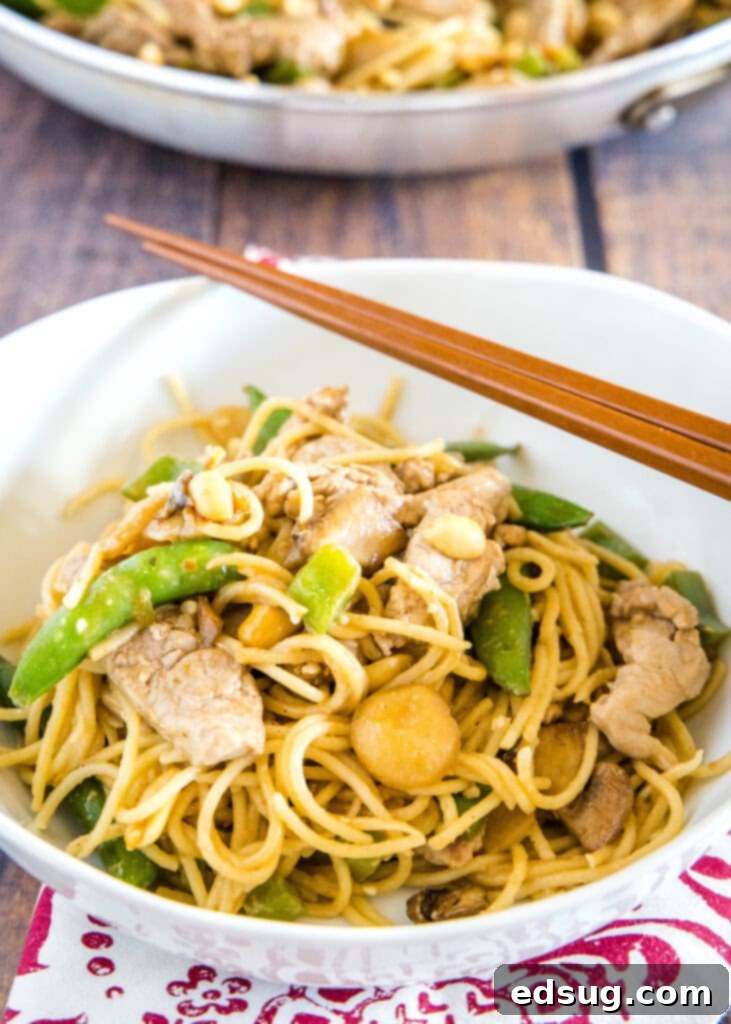
While many associate stir-fries with dishes traditionally served over a bed of fluffy rice, the term “stir-fry” actually refers to the cooking method itself: rapidly tossing and stirring ingredients in a wok or large skillet over high heat with a touch of oil. This technique ensures vegetables remain crisp-tender and proteins cook quickly, locking in their natural juices and maximizing flavor. This inherent flexibility is what makes stir-fries a weeknight hero in many households. It’s an ideal way to transform an assortment of fresh vegetables from your refrigerator into a vibrant, flavorful meal.
Whether you’re trying to encourage family members to eat more greens, utilize leftover produce before it spoils, or simply craving a satisfying meal that feels indulgent yet is surprisingly healthy, a noodle stir fry is almost always a guaranteed hit. Serving it with pasta or noodles often appeals to even the pickiest eaters, making it a clever strategy to introduce new vegetables to your family’s diet.
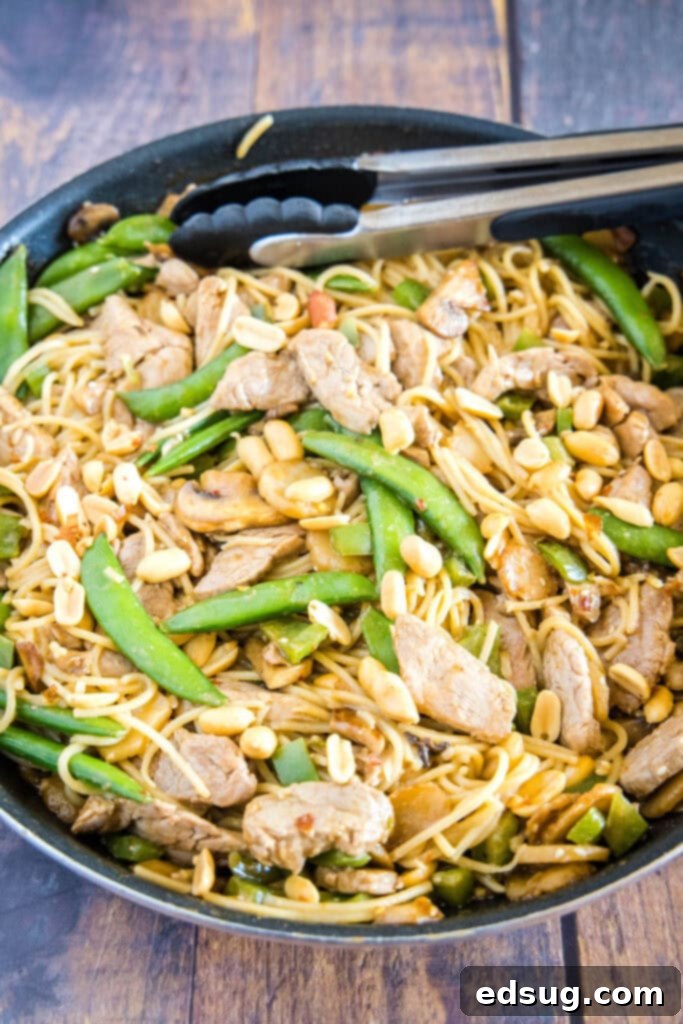
Choosing the Best Noodles for Your Stir Fry
The foundation of any great noodle stir fry is, of course, the noodles! The beauty of this dish lies in its adaptability, and that extends wonderfully to your choice of noodles. While I often reach for common spaghetti due to its pantry staple status and excellent texture, there’s a world of Asian noodles perfectly suited for stir-frying. Each type offers a unique texture and mouthfeel, allowing you to customize your stir fry experience.
- Udon Noodles: These thick, delightfully chewy Japanese wheat noodles have a wonderfully satisfying bite. Their mild flavor makes them a fantastic canvas for absorbing the rich sauces they’re cooked with. Udon noodles are robust enough to stand up to vigorous stirring without breaking down, offering a hearty and substantial base for your stir fry. They bring a comforting, full-bodied element to the dish.
- Lo Mein Noodles (or Chinese Egg Noodles): Often labeled simply as “egg noodles,” these are medium-thick, round, and slightly chewy noodles made from wheat flour and eggs. They’re typically boiled until tender-crisp and then tossed directly into the stir-fry at the end, where they absorb the sauce beautifully. Lo Mein noodles are a classic choice for a reason, providing that authentic “takeout” feel and a comforting texture.
- Rice Noodles (or Rice Sticks): Available in various thicknesses, from very fine vermicelli to wider flat noodles, rice noodles are a lighter, often naturally gluten-free option. They cook very quickly, sometimes just requiring a soak in hot water rather than boiling, and have a delicate, slightly springy texture. If you’re looking for a lighter touch, a different textural element, or need a gluten-free alternative, these are an excellent choice that readily takes on the flavor of your sauce.
- Spaghetti, Fettuccine, or Linguine: Don’t hesitate to use Italian pasta! As I mentioned, spaghetti is my personal go-to for its sheer convenience and universal appeal. Its long, slender strands twine perfectly with the other stir-fry ingredients, and its neutral flavor allows the vibrant stir-fry sauce to truly shine. Fettuccine or linguine, with their broader surfaces, can also work wonderfully, clinging to the sauce and delivering a satisfying mouthful with every bite. The key is to ensure they are cooked al dente so they don’t become mushy in the stir fry.

Selecting the Best Vegetables for Your Stir Fry
One of the best aspects of a homemade stir fry is the freedom to load it with an abundance of fresh, colorful, and nutritious vegetables. The goal is to aim for about 5-6 cups of mixed vegetables to ensure a well-balanced and satisfying meal. While the recipe below includes my family’s favorite combination, feel free to get creative and use whatever fresh produce you have on hand or what your family enjoys most. Remember to cut all vegetables into similar-sized pieces for even cooking and to ensure they cook quickly to a perfect crisp-tender texture.
- Broccoli: These vibrant green florets add fantastic texture and readily absorb the flavors of the sauce. Cut them into small, bite-sized pieces so they cook quickly and become tender-crisp without being soggy.
- Bell Peppers (Any Color): Red, yellow, orange, or green bell peppers bring vibrant color, a hint of natural sweetness, and a lovely crunch. Slice them thinly or into bite-sized squares.
- Cauliflower: Similar to broccoli, cauliflower florets offer a hearty texture and a mild flavor that pairs well with rich sauces. Ensure they are cut into small pieces for quick cooking.
- Sugar Snap Peas & Snow Peas: These legumes offer a delightful crispness and natural sweetness. Add them towards the end of the cooking process to maintain their signature snap and bright green color.
- Water Chestnuts: For a unique, slightly sweet, and wonderfully crunchy texture, canned water chestnuts are a fantastic addition. Drain and slice them before incorporating them into your stir fry.
- Mushrooms: Shiitake, cremini, or white button mushrooms add an earthy depth of flavor and a pleasingly tender texture. They soak up the stir fry sauce beautifully, enhancing the umami profile of the dish.
- Bok Choy: This leafy Chinese cabbage adds a subtle bitterness, freshness, and lovely green color. Separate the stalks and leaves; you can add the thicker stalks slightly earlier and the leaves towards the very end for optimal texture.
- Carrots: Julienne or thinly slice carrots for a touch of sweetness, beautiful orange color, and a firm, satisfying bite.
- Baby Corn: A classic stir-fry ingredient, baby corn provides a gentle crunch and a mild, slightly sweet flavor.
- Onions (Red, Yellow, or Green): Sliced onions or scallions (green onions) add aromatic depth and a pungent kick.
- Zucchini or Yellow Squash: Sliced thinly, these summer squash varieties cook quickly and add moisture and a delicate texture.
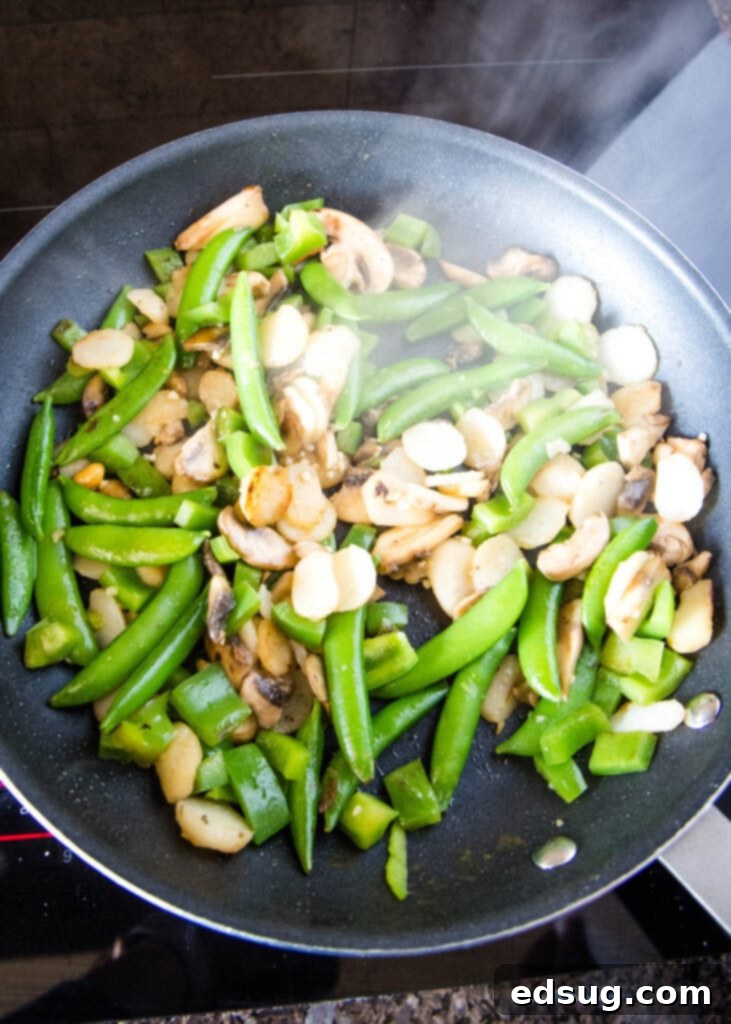
Crafting the Perfect Stir Fry Noodle Sauce
The heart of any exceptional stir fry is its sauce, and this peanut-infused stir fry sauce is nothing short of sensational. It strikes a perfect balance of sweet, savory, and spicy, with a wonderful creamy texture derived from the peanut butter. The Sriracha delivers a pleasant kick that’s easily adjustable to your family’s preferences – if you love heat, feel free to add more at the table or increase the amount in the recipe! The beauty of homemade sauce is complete control over the flavor profile.
I highly recommend using low-sodium soy sauce in all your Asian-inspired dishes. This allows you to control the overall saltiness and prevent the dish from becoming overpowering. While this recipe doesn’t call for additional salt, always taste and adjust seasonings at the very end to achieve your desired flavor. You’ll be amazed at the depth and complexity a homemade sauce can bring to your dish, far surpassing most store-bought alternatives.
Here’s a closer look at the key players in our incredibly flavorful and versatile stir fry sauce:
- Soy Sauce: The backbone of savory umami flavor. Opting for low-sodium is crucial for managing the overall saltiness and balancing the other ingredients.
- Peanut Butter: Provides richness, creaminess, and a wonderfully nutty depth that complements the other Asian flavors beautifully. Creamy peanut butter is preferred for a smooth sauce.
- Honey: Balances the savory and spicy elements with natural sweetness. Maple syrup can also be used as a substitute if you prefer.
- Sesame Oil: Highly aromatic and distinctive, a little goes a long way to add a deeply nutty, toasty flavor that is quintessential to Asian cuisine.
- Sesame Seeds: Adds a subtle crunch and visual appeal as both an ingredient in the sauce and a garnish.
- Fresh Grated Ginger: Essential for that bright, pungent, and warm undertone that truly defines many Asian dishes. Don’t skip fresh ginger for the best flavor!
- Garlic: Another cornerstone of flavor, providing an aromatic base that deepens the sauce’s profile.
- Rice Wine Vinegar: Adds a crucial touch of acidity to cut through the richness of the peanut butter and brighten the overall flavor profile, creating a perfectly balanced sauce.
- Sriracha Sauce: Your customizable heat element. Start with the recommended amount and increase if you prefer it spicier, or reduce for a milder version.
- Crushed Red Pepper: Another layer of heat and a slight textural component, adding visual interest and a subtle bite.
- Pepper: Black pepper rounds out the seasoning, providing a subtle warmth and depth.

Selecting Your Favorite Protein for Stir Fry Noodles
One of the greatest advantages of making stir fry at home is the complete control you have over the protein. Whether you’re a meat-lover, a seafood enthusiast, or prefer a plant-based option, this recipe is incredibly versatile and accommodates a wide range of choices. My family has a particular fondness for pork, and I find thinly sliced pork tenderloin cooks up beautifully, remaining tender and juicy. However, you can easily swap it for any of the following, or even combine a couple for more variety and flavor:
- Chicken Breast or Thighs: Thinly slice boneless, skinless chicken breast or thigh into bite-sized pieces. Chicken thighs tend to stay juicier and are more forgiving if slightly overcooked. For best results, consider a quick marinade (even just soy sauce and a touch of cornstarch) before cooking to ensure maximum tenderness and flavor.
- Pork Tenderloin: As used in this recipe, pork tenderloin slices cook very quickly and remain incredibly tender. Ensure uniform thin slices for even cooking and a consistent texture throughout the dish. You can also use thinly sliced pork chops.
- Sirloin Steak or Flank Steak: For a hearty beef stir fry, thinly slice sirloin or flank steak against the grain. This technique is crucial for tender beef. Marinating beef for 15-30 minutes with a little soy sauce, sesame oil, and cornstarch can further enhance its tenderness and absorb flavor.
- Shrimp: Quick-cooking and delicious, shrimp adds a lovely seafood twist to your stir fry. Opt for medium or large shrimp, peeled and deveined. Add shrimp towards the very end of the cooking process, as they cook in just a few minutes to avoid overcooking and a rubbery texture.
- Tofu: For a fantastic vegetarian or vegan option, firm or extra-firm tofu is ideal. Press the tofu to remove excess water, then cube it and pan-fry or bake until golden and slightly crispy before adding to the stir fry. This ensures it holds its shape and texture beautifully and absorbs the sauce’s flavors.
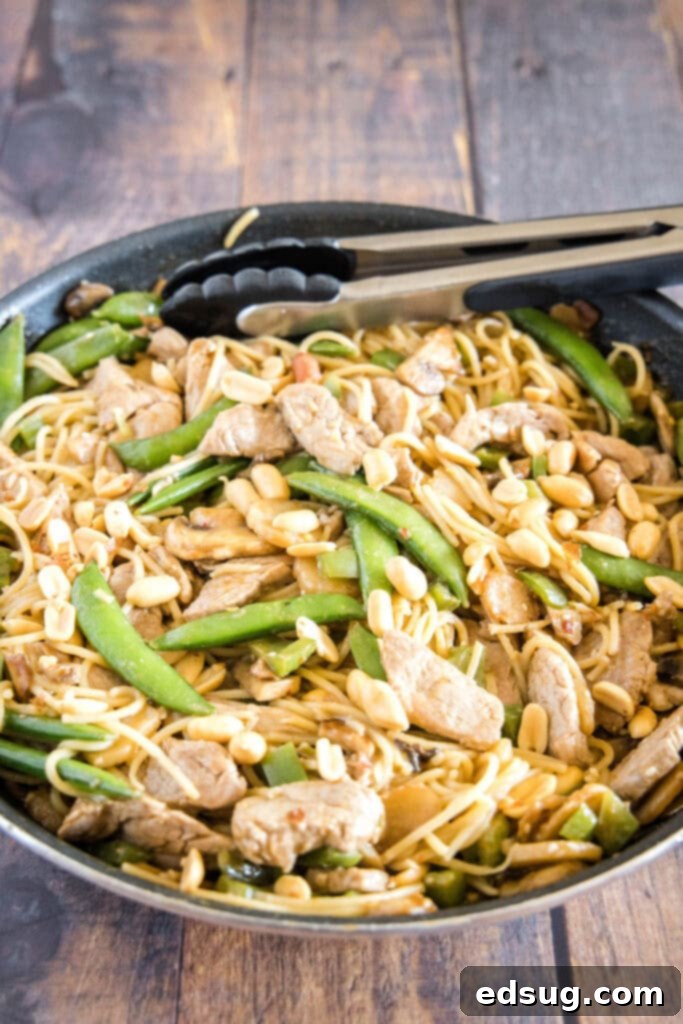
How to Make Perfect Stir Fry Noodles: Step-by-Step Guide
Crafting the perfect stir fry is all about speed and preparation, a culinary concept known as ‘mise en place’ – having all your ingredients prepped, measured, and ready before you even turn on the heat. Things move quickly in a wok or large skillet, so having everything at your fingertips ensures a stress-free and successful cooking experience, resulting in tender-crisp vegetables, perfectly cooked protein, and flavorful noodles.
- Prep Your Produce: Begin by thoroughly washing all your chosen vegetables. Meticulously cut them into uniform, bite-sized pieces. Consistency in size is key for even cooking. For tougher vegetables like broccoli florets or carrots, aim for smaller cuts to ensure they cook quickly to your desired tenderness. Set all prepped vegetables aside in a bowl.
- Whisk the Sauce: In a liquid measuring cup or a small bowl, combine all the ingredients for your phenomenal stir fry sauce. Whisk vigorously until the peanut butter is fully incorporated and the sauce is smooth and homogeneous. If the peanut butter is particularly thick, you might need to warm it slightly or whisk a little extra soy sauce to loosen it. Set this flavorful mixture aside, ready for its grand entrance into the pan.
- Cook the Noodles: Bring a large pot of salted water to a rolling boil. Add your chosen noodles (spaghetti, udon, lo mein, etc.) and cook them according to the package directions until they are al dente – cooked through but still firm to the bite. Do not overcook them, as they will continue to cook slightly when added to the stir fry. Drain them well and you can toss them with a tiny bit of sesame oil to prevent sticking, then set aside.
- Brown the Protein: Heat a large skillet or wok over high heat and add a teaspoon of olive oil (or your preferred cooking oil with a high smoke point). Once the oil is shimmering and hot, add your thinly sliced pork tenderloin (or other chosen protein). Cook for just 3-4 minutes, stirring frequently, until the outside is beautifully browned and seared. It doesn’t need to be cooked through at this stage; it will finish cooking in the sauce later. Remove the protein from the pan and set it aside on a clean plate.
- Sauté the Veggies: Return the skillet to medium-high heat. Add a bit more oil if needed. Introduce your prepared vegetables to the pan, starting with any harder vegetables (like carrots or broccoli) first, then adding softer ones (like bell peppers or mushrooms). Cook for 5-7 minutes, stirring constantly, until they are tender-crisp – you want them cooked but still with a slight bite. If using leafy greens like bok choy, add them in the last minute or two for optimal freshness.
- Combine & Simmer: Return the partially cooked protein to the pan with the tender-crisp vegetables. Pour in your prepared stir fry sauce. Stir everything together meticulously to ensure all ingredients are coated evenly with the rich sauce. Let the mixture simmer for 4-5 minutes, allowing the sauce to thicken slightly and the protein to cook completely through, absorbing all those incredible flavors.
- Toss with Noodles: Finally, add your cooked and drained noodles to the skillet. Using tongs, toss everything together meticulously until the noodles are thoroughly coated in the rich, glossy sauce and perfectly integrated with the protein and vegetables. Ensure an even distribution of all ingredients.
- Serve & Garnish: Divide the stir fry among serving bowls. Garnish generously with chopped peanuts for an extra layer of crunch and fresh green onions for a burst of vibrant flavor and color. Serve immediately and enjoy your homemade takeout masterpiece!
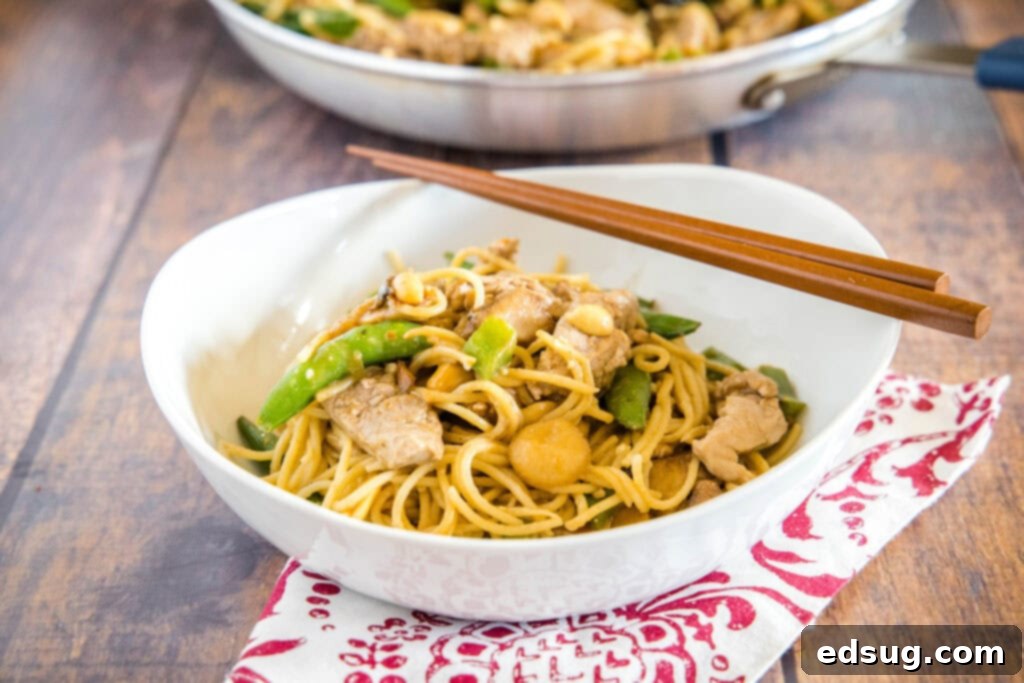
The allure of homemade meals, especially when they rival or surpass your favorite restaurant dishes, is undeniable. Making your own stir fry noodles at home is not only surprisingly simple and incredibly fast—often quicker than waiting for delivery or pickup—but it also offers a multitude of benefits. You become the master of your meal, dictating every ingredient. Want extra veggies? Go for it! Craving more heat? Dial up the Sriracha! Dislike broccoli? Simply omit it or swap it for something you love. This level of customization ensures that even the pickiest eaters at your table will find something to enjoy and can help you cater to various dietary needs.
Beyond personal preference, preparing stir fry at home means you have complete transparency regarding ingredient quality. You can choose fresh, whole ingredients, opt for low-sodium soy sauce, and avoid excessive sugars, artificial additives, or unhealthy oils often found in commercially prepared sauces and takeout dishes. The result is a fresher, healthier, and ultimately more satisfying meal that tastes infinitely better because you made it yourself. This recipe gives you the power to create a wholesome, flavorful dinner without compromise. So, the next time that craving for savory, spicy, and satisfying Asian noodles strikes, remember this recipe. It’s your ticket to a delicious, quick, and customized dinner that will undoubtedly become a beloved staple in your culinary repertoire.
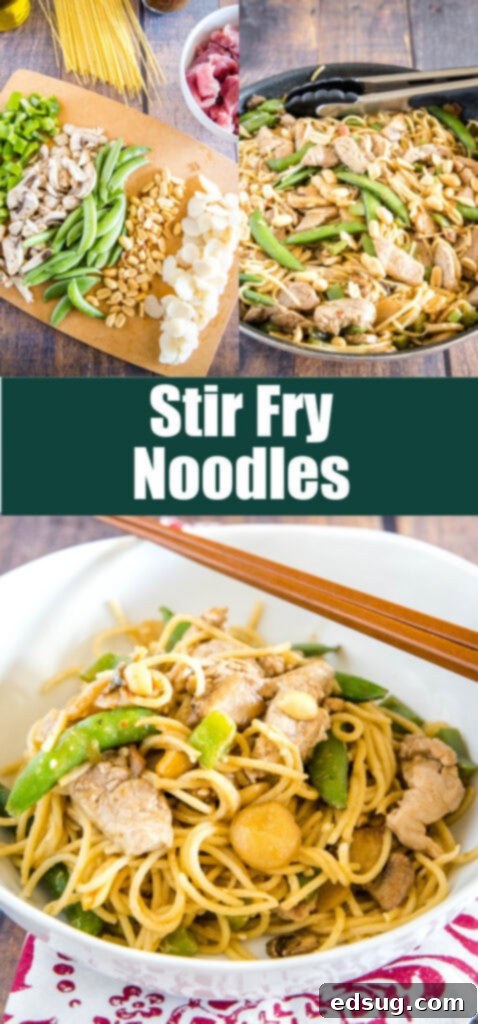
More Delicious Asian Dinner Recipes
If you loved these stir fry noodles, you’re in for a treat! Explore more of our favorite Asian-inspired dishes that are perfect for weeknight meals or entertaining:
- Chicken Lo Mein
- Egg Drop Soup
- Easy Cashew Chicken
- Pork Lo Mein
- Chow Mein with Chicken
- General Tso’s Chicken
- Wonton Soup
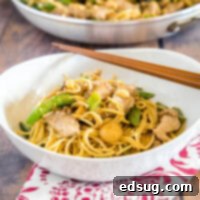
Stir Fry Noodles
Pin Recipe
Rate Recipe
Print Recipe
Ingredients
For Sauce:
- 1/3 cup soy sauce
- 2 Tablespoon creamy peanut butter
- 1 Tablespoon honey
- 1 teaspoon sesame oil
- 1 teaspoon sesame seeds
- 1 teaspoon fresh grated ginger
- 1 garlic clove, minced
- 1 teaspoon rice wine vinegar
- 1 teaspoon Sriracha sauce
- 1 teaspoon crushed red pepper
- 1/2 teaspoon black pepper
For the Stir Fry:
- 8 oz pork tenderloin, or other protein thinly sliced
- 1 teaspoon olive oil
- 1 garlic clove minced
- 8 oz mushrooms, chopped
- 2 cups sugar snap peas
- 1 can water chestnuts, drained
- 1 green bell pepper, chopped
- 8 oz pasta, spaghetti, udon noodles etc
Toppings
- 2 Tablespoons chopped peanuts
- 1/4 cup green onions, chopped
Instructions
-
Measure the ingredients for the sauce, stir until well combined. Set aside.
-
Bring a large pot of water to boil and cook pasta according to package instructions.
-
Meanwhile in a large skillet over high heat add pork tenderloin and cook for 3-4 minutes, until browned on the outside, but not fully cooked. Remove from pan and set aside.
-
Return the skillet to medium high heat and add the oil. Add the vegetables and cook for 5-7 minutes until they are tender.
-
Add the meat back in and pour in the sauce. Simmer for 4-5 minutes until the meat is cooked.
-
Toss with pasta until everything is well coated.
-
Serve topped with peanuts and green onions.
Notes
Nutrition
Nutrition information is automatically calculated, so should only be used as an approximation.
Additional Info
Like this recipe? Leave a comment below!
I created a fun group on Facebook, and I would love for you to join us! It’s a place where you can
share YOUR favorite recipes, ask questions, and see what’s new at Dinners, Dishes and Desserts (so that you never miss a new recipe)!
Be sure to follow me on Instagram and
tag #dinnersdishes so I can see all the wonderful DINNERS, DISHES, AND DESSERTS
recipes YOU make!
Be sure to follow me on my social media, so you
never miss a post!
Facebook | Twitter | Pinterest | Instagram
